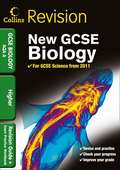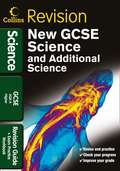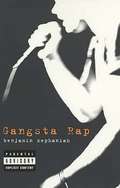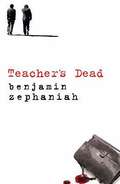- Table View
- List View
GCSE Biology AQA A: Revision Guide and Exam Practice Workbook (PDF)
by Gemma Young Sarah JinksCollins all-in-one revision guide and exam practice workbook for GCSE Biology shows how each student can follow their level, test their knowledge, check their answers and improve.
GCSE Science & Additional Science AQA A Higher: Revision Guide and Exam Practice Workbook (PDF)
by Gemma Young Nicky Thomas Rob WensleyAll-in-one Collins Revision Guides and Workbooks give you everything you need to improve your exam grade in GCSE AQA Higher Science. Accessible content, practical guidance and sample questions with detachable answers help you revise and practise, check your progress and improve your level.
Gangsta Rap (PDF)
by Benjamin ZephaniahRay has been excluded from school and attends a Social Exclusion Project which means he can develop his music skills. However, another rap band takes a dislike to Ray's music and gang warfare is the result.
Teacher's Dead (1st edition) (PDF)
by Benjamin ZephaniahA teacher is dead, murdered by two of his students in front of the school. He was a good man. People liked him. So how could this happen? Why? It just doesn't make sense to Jackson, and he is determined to investigate the case until he understands.
Terror Kid (PDF)
by Benjamin ZephaniahWhat is a terrorist? A shocking, moving and timely novel about the choices that shape us. Rico knows trouble. He knows the look of it and the sound of it. He also knows to stay away from it as best he can. Because if there's one thing his Romany background has taught him, it's that he will always be a suspect. Despite his efforts to stay on the right side of the law, Rico is angry and frustrated at the injustices he sees happening at home and around the world. He wants to do something - but what? When he is approached by Speech, a mysterious man who shares Rico's hacktivist interests, Rico is given the perfect opportunity to speak out. After all, what harm can a peaceful cyber protest do...? From the bestselling author of REFUGEE BOY comes a powerful novel about justice, trust and idealism gone wrong that will make you look again at your definition of a terrorist.
Climate Graph - Cool, temperate maritime: Shannon, Ireland (Large Print)
This is a graph showing temperature and precipitation over the period of a year in Shannon. There is a locator dot shown, which will be at the top left of the page when the image is the right way up. There are vertical bars indicating average monthly rainfall and a thick dashed line going across the page showing the average monthly temperature. On the left of the page is a vertical scale marked in degrees Centigrade starting from zero at the bottom. It is marked at every five degrees and labelled at every ten degrees. Running right across the page are fine horizontal grid lines. The thick dashed line representing the temperature can be found at the bottom left of the page sloping up and down to right. Across the bottom of the page are twelve labelled vertical bars showing the rainfall for each month of the year, starting with January on the left. To allow sufficient space, the braille labels are uncapitalised. At the far right of the page is a vertical scale of precipitation in millimetres, starting with zero at the bottom. This is marked every 25 mm and labelled every 50 mm.
Climate Graph - Cool, temperate maritime: Shannon, Ireland (UEB Contracted)
This is a graph showing temperature and precipitation over the period of a year in Shannon. There is a locator dot shown, which will be at the top left of the page when the image is the right way up. There are vertical bars indicating average monthly rainfall and a thick dashed line going across the page showing the average monthly temperature. On the left of the page is a vertical scale marked in degrees Centigrade starting from zero at the bottom. It is marked at every five degrees and labelled at every ten degrees. Running right across the page are fine horizontal grid lines. The thick dashed line representing the temperature can be found at the bottom left of the page sloping up and down to right. Across the bottom of the page are twelve labelled vertical bars showing the rainfall for each month of the year, starting with January on the left. To allow sufficient space, the braille labels are uncapitalised. At the far right of the page is a vertical scale of precipitation in millimetres, starting with zero at the bottom. This is marked every 25 mm and labelled every 50 mm.
Climate Graph - Cool, temperate maritime: Shannon, Ireland (UEB Uncontracted)
This is a graph showing temperature and precipitation over the period of a year in Shannon. There is a locator dot shown, which will be at the top left of the page when the image is the right way up. There are vertical bars indicating average monthly rainfall and a thick dashed line going across the page showing the average monthly temperature. On the left of the page is a vertical scale marked in degrees Centigrade starting from zero at the bottom. It is marked at every five degrees and labelled at every ten degrees. Running right across the page are fine horizontal grid lines. The thick dashed line representing the temperature can be found at the bottom left of the page sloping up and down to right. Across the bottom of the page are twelve labelled vertical bars showing the rainfall for each month of the year, starting with January on the left. To allow sufficient space, the braille labels are uncapitalised. At the far right of the page is a vertical scale of precipitation in millimetres, starting with zero at the bottom. This is marked every 25 mm and labelled every 50 mm.
Climate Graph- Mediterranean: Rome, Italy (Large Print)
This is a graph showing temperature and precipitation over the period of a year in Rome. There is a locator dot shown, which will be at the top left of the page when the image is the right way up. There are vertical bars indicating average monthly rainfall and a thick dashed line going across the page showing the average monthly temperature. On the left of the page is a vertical scale marked in degrees Centigrade starting from zero at the bottom. It is marked at every five degrees and labelled at every ten degrees. Running right across the page are fine horizontal grid lines. The thick dashed line representing the temperature can be found at the bottom left of the page sloping up and down to right. Across the bottom of the page are twelve labelled vertical bars showing the rainfall for each month of the year, starting with January on the left. To allow sufficient space, the braille labels are uncapitalised. At the far right of the page is a vertical scale of precipitation in millimetres, starting with zero at the bottom. This is marked every 25 mm and labelled every 50 mm.
Climate Graph- Mediterranean: Rome, Italy (UEB Contracted)
This is a graph showing temperature and precipitation over the period of a year in Rome. There is a locator dot shown, which will be at the top left of the page when the image is the right way up. There are vertical bars indicating average monthly rainfall and a thick dashed line going across the page showing the average monthly temperature. On the left of the page is a vertical scale marked in degrees Centigrade starting from zero at the bottom. It is marked at every five degrees and labelled at every ten degrees. Running right across the page are fine horizontal grid lines. The thick dashed line representing the temperature can be found at the bottom left of the page sloping up and down to right. Across the bottom of the page are twelve labelled vertical bars showing the rainfall for each month of the year, starting with January on the left. To allow sufficient space, the braille labels are uncapitalised. At the far right of the page is a vertical scale of precipitation in millimetres, starting with zero at the bottom. This is marked every 25 mm and labelled every 50 mm.
Climate Graph- Mediterranean: Rome, Italy (UEB Uncontracted)
This is a graph showing temperature and precipitation over the period of a year in Rome. There is a locator dot shown, which will be at the top left of the page when the image is the right way up. There are vertical bars indicating average monthly rainfall and a thick dashed line going across the page showing the average monthly temperature. On the left of the page is a vertical scale marked in degrees Centigrade starting from zero at the bottom. It is marked at every five degrees and labelled at every ten degrees. Running right across the page are fine horizontal grid lines. The thick dashed line representing the temperature can be found at the bottom left of the page sloping up and down to right. Across the bottom of the page are twelve labelled vertical bars showing the rainfall for each month of the year, starting with January on the left. To allow sufficient space, the braille labels are uncapitalised. At the far right of the page is a vertical scale of precipitation in millimetres, starting with zero at the bottom. This is marked every 25 mm and labelled every 50 mm.
Congruency
This diagram consists of two pairs of congruent shapes; two triangles in the middle of the page and two irregular shapes at the bottom of the page. A locator dot and title are shown. These must always be at the top left of the page when the image is the right way up. The top two are congruent - the one on the right is in a mirrored position. The diagram shows how their congruency is proved. The bottom two are also congruent - the one on the right is in a rotated position. When shapes are congruent they are the same size and shape but can be rotated and/or mirrored.
Congruency
This diagram consists of two pairs of congruent shapes; two triangles in the middle of the page and two irregular shapes at the bottom of the page. A locator dot and title are shown. These must always be at the top left of the page when the image is the right way up. The top two are congruent - the one on the right is in a mirrored position. The diagram shows how their congruency is proved. The bottom two are also congruent - the one on the right is in a rotated position. When shapes are congruent they are the same size and shape but can be rotated and/or mirrored.
Cross section of a ball and socket joint (Large Print)
The hip socket is in the top left of the page and the ball of the femur is in the centre of the page. The diagram is surrounded by an image border. A locator dot and title are shown. These must always be at the top left of the page when the image is the right way up. The upper end of the femur is in the bottom right of the page. It leads up to the femoral head which connects to the ball of the joint. The joint has a ligament holding the two bones together to the upper right and lower left of the page.
Cross section of a ball and socket joint (UEB Contracted)
The hip socket is in the top left of the page and the ball of the femur is in the centre of the page. The diagram is surrounded by an image border. A locator dot and title are shown. These must always be at the top left of the page when the image is the right way up. The upper end of the femur is in the bottom right of the page. It leads up to the femoral head which connects to the ball of the joint. The joint has a ligament holding the two bones together to the upper right and lower left of the page.
Cross section of a ball and socket joint (UEB Uncontracted)
The hip socket is in the top left of the page and the ball of the femur is in the centre of the page. The diagram is surrounded by an image border. A locator dot and title are shown. These must always be at the top left of the page when the image is the right way up. The upper end of the femur is in the bottom right of the page. It leads up to the femoral head which connects to the ball of the joint. The joint has a ligament holding the two bones together to the upper right and lower left of the page.
Cross section of a synovial joint (Large Print)
There is a bone at the top of the page, the joint in the centre of the page and another bone at the bottom of the page. The diagram is surrounded by an image border. A locator dot and title are shown. These must always be at the top left of the page when the image is the right way up. The bone in the top part of the page ends in the centre of the page, where it is covered with cartilage. Similarly the bone in the bottom part of the page ends in the centre of the page and is also covered with cartilage. To the left and right a ligament holds the two bones together. There is fluid between the two areas of cartilage which is held in place by a membrane.
Cross section of a synovial joint (UEB Contracted)
There is a bone at the top of the page, the joint in the centre of the page and another bone at the bottom of the page. The diagram is surrounded by an image border. A locator dot and title are shown. These must always be at the top left of the page when the image is the right way up. The bone in the top part of the page ends in the centre of the page, where it is covered with cartilage. Similarly the bone in the bottom part of the page ends in the centre of the page and is also covered with cartilage. To the left and right a ligament holds the two bones together. There is fluid between the two areas of cartilage which is held in place by a membrane.
Cross section of a synovial joint (UEB Uncontracted)
There is a bone at the top of the page, the joint in the centre of the page and another bone at the bottom of the page. The diagram is surrounded by an image border. A locator dot and title are shown. These must always be at the top left of the page when the image is the right way up. The bone in the top part of the page ends in the centre of the page, where it is covered with cartilage. Similarly the bone in the bottom part of the page ends in the centre of the page and is also covered with cartilage. To the left and right a ligament holds the two bones together. There is fluid between the two areas of cartilage which is held in place by a membrane.
Cross section of the left human lung (Large Print)
This diagram shows the left lung, its bronchus and part of the trachea seen from the front and surrounded by an image border. A locator dot and title are shown. These must always be at the top left of the page when the image is the right way up. In the top left of the diagram the lower part of the trachea runs down the page a short way, before dividing into the two bronchi. The left bronchus goes down and to the right of the page, and enters the left lung. It divides many times into bronchioles, each of which ends in an alveolus.
Cross section of the left human lung (UEB Contracted)
This diagram shows the left lung, its bronchus and part of the trachea seen from the front and surrounded by an image border. A locator dot and title are shown. These must always be at the top left of the page when the image is the right way up. In the top left of the diagram the lower part of the trachea runs down the page a short way, before dividing into the two bronchi. The left bronchus goes down and to the right of the page, and enters the left lung. It divides many times into bronchioles, each of which ends in an alveolus.
Cross section of the left human lung (UEB Uncontracted)
This diagram shows the left lung, its bronchus and part of the trachea seen from the front and surrounded by an image border. A locator dot and title are shown. These must always be at the top left of the page when the image is the right way up. In the top left of the diagram the lower part of the trachea runs down the page a short way, before dividing into the two bronchi. The left bronchus goes down and to the right of the page, and enters the left lung. It divides many times into bronchioles, each of which ends in an alveolus.
Development of a tropical storm - cross section (Large Print)
This page shows a tropical storm in cross section (cut through vertically and seen from the side). There is a locator dot shown, which will be at the top left of the page when the image is the right way up. The diagram has a dashed line image border. In the middle of the page there are arrows pointing down, and to either side of these the cross section through the clouds can be found. Going across the bottom of the page is a textured area representing the sea. The straight arrows in the middle of the page represent the flow of air down into the clear 'eye' of the storm system. To either side are textured areas of cloud. Within these textured areas, wiggly arrows show water vapour rising through the cloud from the sea. Rain is shown falling from the cloud to the sea at the bottom of the page. Three horizontal arrows, pointing right, can be found on the left of the page just above the sea. Three similar arrows, pointing left, can be found just above the sea on the right of the page. These all show airflow into the storm system.
Development of a tropical storm - cross section (UEB Contracted)
This page shows a tropical storm in cross section (cut through vertically and seen from the side). There is a locator dot shown, which will be at the top left of the page when the image is the right way up. The diagram has a dashed line image border. In the middle of the page there are arrows pointing down, and to either side of these the cross section through the clouds can be found. Going across the bottom of the page is a textured area representing the sea. The straight arrows in the middle of the page represent the flow of air down into the clear 'eye' of the storm system. To either side are textured areas of cloud. Within these textured areas, wiggly arrows show water vapour rising through the cloud from the sea. Rain is shown falling from the cloud to the sea at the bottom of the page. Three horizontal arrows, pointing right, can be found on the left of the page just above the sea. Three similar arrows, pointing left, can be found just above the sea on the right of the page. These all show airflow into the storm system.
Development of a tropical storm - cross section (UEB Uncontracted)
This page shows a tropical storm in cross section (cut through vertically and seen from the side). There is a locator dot shown, which will be at the top left of the page when the image is the right way up. The diagram has a dashed line image border. In the middle of the page there are arrows pointing down, and to either side of these the cross section through the clouds can be found. Going across the bottom of the page is a textured area representing the sea. The straight arrows in the middle of the page represent the flow of air down into the clear 'eye' of the storm system. To either side are textured areas of cloud. Within these textured areas, wiggly arrows show water vapour rising through the cloud from the sea. Rain is shown falling from the cloud to the sea at the bottom of the page. Three horizontal arrows, pointing right, can be found on the left of the page just above the sea. Three similar arrows, pointing left, can be found just above the sea on the right of the page. These all show airflow into the storm system.





